
A recent study reveals the profound impact of pollution on cloud behavioוr. This newfound understanding illuminates the intricate ways in which pollution alters our climate. Such research marks a significant stride in comprehending the influence of pollution on our weather and broader climate dynamics. Emphasising the need to factor in both localised cloud formations and overarching climate patterns, it underscores the criticality of considering all scales in studying the effects of pollution on our climate.
The interplay between human-induced aerosols and cloud dynamics stands as a pivotal factor in unravelling the intricacies of our climate system. Despite its significance, reconciling the vast scale disparities between cloud formations, spanning approximately 1 to 10 kilometres, and the broader atmospheric circulation and climate patterns extending over 1,000 kilometers has posed a significant challenge.
Taking on this task, Dr. Guy Dagan and his research team at the Hebrew University of Jerusalem, together with researchers from Princeton University, embarked on a new study. Their focus was on understanding how minuscule pollution particles, known as aerosols, interact with clouds in the sky—an interaction that profoundly shapes our climate. However, a fundamental hurdle lay in the mismatched scales: clouds, small in scale, juxtaposed against expansive climate patterns, akin to fitting puzzle pieces from different sets.
The innovative approach employed by Dr. Dagan’s team involved sophisticated computer simulations capable of examining the minute details of the sky while capturing the broader essence of the entire climate system. Through a meticulously crafted series of simulations, the team dissected mechanism involving changes in the large-scale circulation due to air pollution. Their comparative analysis revealed a compelling revelation: the presence of aerosols triggers changes in large-scale circulation, which in turn substantial enhances the effective radiative forcing i.e., the effect of human activity on the climate system.
One key finding was that more aerosols stop rain in some areas. This makes moisture move to places where big clouds form. These big clouds then release more heat into the air and cause stronger winds.
Dr. Guy Dagan explains, “Our study helps us understand better how aerosols and clouds affect the climate. The changes caused by aerosols come from complex shifts in big weather patterns, showing us an important part of how these interactions affect the climate.”
The research paper titled “Radiative forcing from aerosol–cloud interactions enhanced by large-scale circulation adjustments” was published in Nature Geoscience and can be read at https://rdcu.be/drzoC.
Researchers
Guy Dagan1, Netta Yeheskel1 & Andrew I. L. Williams2
Institutions
1) Fredy and Nadine Herrmann Institute of Earth Sciences, Hebrew University
2) Program in Atmosphere and Ocean Sciences, Princeton
Picture:
Title: Cloud–circulation coupling under clean and polluted conditions.

A schematic representation of the coupling between clouds and circulation in the tropics under clean conditions (top) and the response of this coupled system to an increase in air pollution concentration (bottom). It demonstrates that under polluted conditions the circulation becomes stronger, which intensifies the cloudiness that acts to cool the planet.
Credit: Guy Dagan
Disclaimer: In these challenging times of war and crisis, Hebrew University of Jerusalem is resolute in its dedication to advancing research and education. We stand in full support of the brave individuals on the frontlines, safeguarding our nation and the well-being of all Israelis, and extend our deepest gratitude and unwavering solidarity to our community and fellow citizens. Together, we shall prevail against the challenges that confront us, and our shared commitment to the well-being of all Israelis and the pursuit of knowledge remains resolute.
The Hebrew University of Jerusalem is Israel’s premier academic and research institution. With over 25,000 students from 90 countries, it is a hub for advancing scientific knowledge and holds a significant role in Israel’s civilian scientific research output, accounting for nearly 40% of it and has registered over 11,000 patents. The university’s faculty and alumni have earned eight Nobel Prizes and a Fields Medal, underscoring their contributions to ground-breaking discoveries. In the global arena, the Hebrew University ranks 86th according to the Shanghai Ranking. To learn more about the university’s academic programs, research initiatives, and achievements, visit the official website at http://new.huji.ac.il/en
